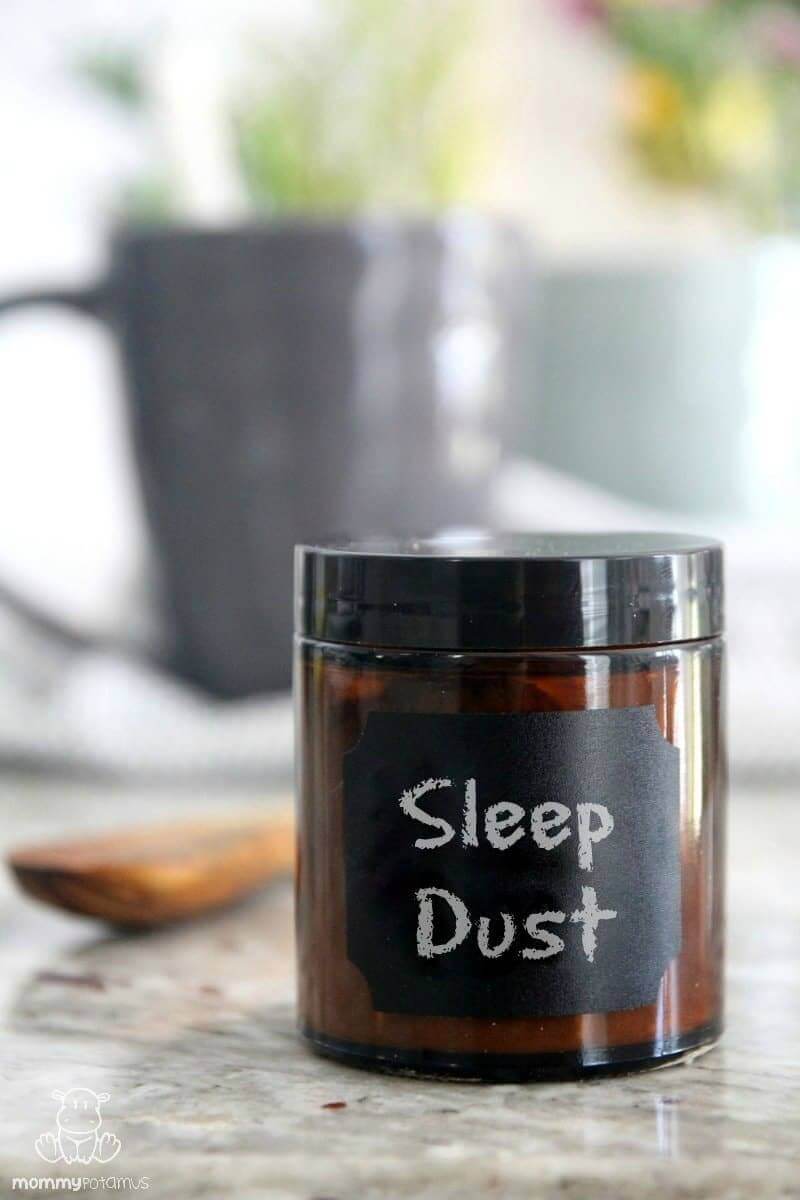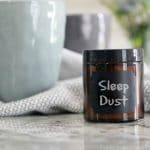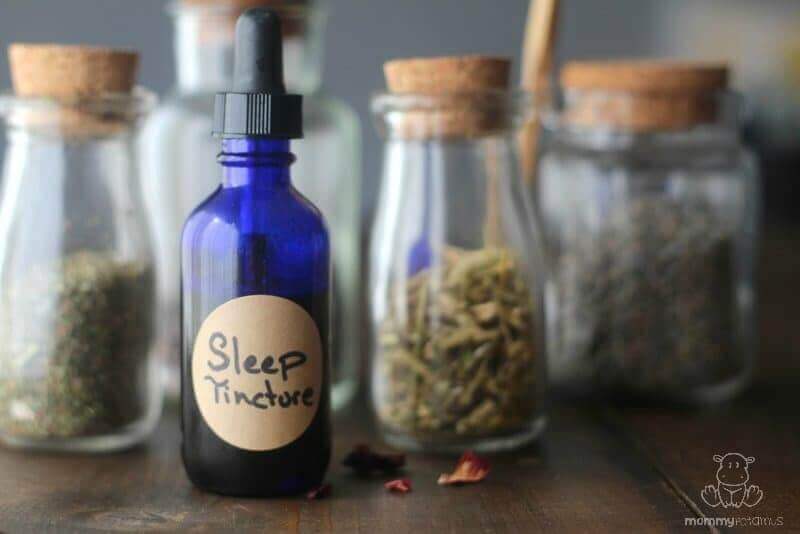If you’ve been around here for long, you know that I am 100% dedicated to sleep. I am not afraid to go orange-alien faced to combat sleep-busting blue-light, slather butter on my body if it will increase sleep-promoting magnesium, or even drink bananas (B.A.N.A.N.A.S.).
So you can bet I jumped at the chance to work with registered herbalist Lori Valentine Rose, RH (AHG), a professor at Hill College’s Holistic Wellness Pathway, to create a homemade, evidence-based, five-flavor dust to ship me (and you) right off to sleep (and away from counting sheep).
What is sleep dust?
You’re probably no stranger to sleepy tea recipes, but there are probably nights when you feel tired and wired – that is, too tired to bother with brewing and straining a cup a tea, but too wired to drift off to sleep. Sleep dust is similar to this mushroom coffee packet – which I keep in my purse at all times just in case I need an emergency cup of coffee – only instead of promoting alertness, it’s an instant cup of powerful sleep promoting herbs.
This recipe is super simple to prepare – just stir the powder into hot water and sip your way to sleepiness.
About the ingredients
Traditional Chinese Medicine considers all herbal formulas to be incomplete until they are composed of all five flavor profiles: aromatic, sour, bitter, salty, and sweet. Five-flavor formulations ensure that all the diverse benefits the plant world has to offer are included in every remedy.
This sleep dust not only contains herbs that modern research has found helpful in setting you adrift to dreamland, but also follows traditional TCM methods of creating a complete five-flavor formula. Here’s what we’ll be incorporating:
Aromatics
Aromatics are known to be relaxing and antispasmodic, perfect ingredients for easing stress and tension in our magic formula. (Nolan et. al., Lis-Balchin et. al.) The aromatics in the spotlight are:
- Lavender – Famous for its ability to improve sleep quality, you can bet lavender debuts in our five-flavor sleep dust. Researchers have found that volunteers who inhaled lavender oil before bed experienced increased theta and alpha brainwave activity during sleep, allowing volunteers wake up feeling more refreshed. (Lytle) It has also been shown to support a relaxed state by decreasing heart rate and blood pressure. Lavender is given the highest safety rating in the Botanical Safety Handbook, 2nd edition.
- Catnip – This herb doesn’t just send your family pet off to bliss; it’s what herbalists call a “relaxing nervine”, which means that it helps create a sense of peace, calms overstimulation, and eases forehead tension and motion sickness. Catnip is also slightly sedative, and is often sipped as a tea before bed to help with sleep. Catnip is given the highest safety rating in the Botanical Safety Handbook, 2nd edition.
Sour
In Chinese medicine, the sour flavor is thought to be calming. It’s also known to contain anti-oxidants and organic acids that support digestion, easing tummy troubles that might be preventing sleep. Our spotlight sour herb is:
- Lemon Balm – Named for it’s bright, lemony flavor, lemon balm “has long been treasured for its calming and relaxing properties. Herbalists classify it as a relaxing nervine, an herb that relaxes, soothes, and supports the nervous system.” (de la Foret) Lemon balm is given the highest safety rating in the Botanical Safety Handbook, 2nd edition.
Bitter
Bitter herbs have been banished to the outskirts of society in recent decades, but the bitter flavor is known to support balanced blood sugar. When blood sugar is out of balance, we can wake up in hypoglycemic stress in the middle of the night. Using bitters to keep our blood sugar on an even keel can help us get a full-night’s slumber. Our bitter herb is:
- Chamomile – “For years I was wrong about chamomile,” writes herbalist Rosalee de la Foret, “I thought of it as gentle and therefore, weak. I thought that because it was safe enough for little ones (like Peter Rabbit), it wasn’t effective for the more serious problems of adults. But that is the beautiful secret of chamomile. As beloved herbalist Rosemary Gladstar so wisely says, ‘Chamomile demonstrates to us that gentle does not mean less effective.” (de la Foret)
She continues by saying that “Drinking a cup of chamomile tea is like getting a warm hug from a loved one. It can help you relax and unwind after a stressful day, decrease pain caused by muscle tension or spasms, and strongly reduce inflammation. Chamomile’s best gifts are that it is gentle while simultaneously offering profound relief.” (de la Foret)
Chamomile is given the highest safety rating in the Botanical Safety Handbook, 2nd edition. However, chamomile is in the aster family (think ragweed), so if you have a a ragweed allergy it’s probably best to avoid it.
Salty
Salty herbs don’t make their way into many sleep formulas, but there is a benefit to including this flavor in our sleep dust. The salty flavor profile signifies the presence of minerals, and minerals support neurotransmitter formation. Instead of reaching for potentially habit-forming melatonin, frequent use of nutritive, “salty” herbs can provide the building blocks your body needs to make its own sleep neurotransmitters. We’ll be using:
- Oatstraw – This nutritive herb is used for long-term relaxation and nervous system support, which is crucial for letting go of daily stressors that tend to rob us of our peaceful dreams. This might be because it is high in magnesium, known as the “magic mineral” for inducing calm. (Pederson) Oatstraw can be used in amounts as high as 1 ounce per day, so if all the bitter and sour flavors are offending your tongue, you can increase the amounts to balance out the flavors. Oatstraw is given the highest safety rating in the Botanical Safety Handbook, 2nd edition.
Sweet
Sweet herbs generally build up the body over the long term, but here we are including this flavor to balance out the bitter sleep-inducing magic and to provide that five-flavor balance. And so you can have sweet dreams, of course. Our spotlight herb is:
- Stevia – Stevia should be used in its whole-herb form because refined versions often contain unwanted additives and fillers. You can use a little, or you can use a lot, so feel free to experiment and find your own dose of this sweet herb. Stevia is given the highest safety rating in the Botanical Safety Handbook, 2nd edition.
How to Use Sleep Dust
Thanks to the diversity of herbs in this formula, this five-flavor sleep dust supports sleep via multiple biological pathways. Stir 1.5 teaspoons (or more if desired) into once cup of hot water in the evening when you’re feeling tired but can’t unwind, when your tight neck, back, and shoulder muscles are preventing deep, restful sleep, or when stomach upset is preventing you from relaxing.

How To Make Five Flavor Sleep Dust
Equipment
Ingredients
- 3 tbsp plus 1 tsp lavender powder (aromatic sleep dust)
- 3 tbsp plus 1 tsp catnip powder (aromatic sleep dust)
- 2 tbsp chamomile powder (bitter sleep dust)
- 3 tbsp plus 1 teaspoon lemon balm leaf powder (sour sleep dust)
- 2 tbsp oatstraw powder (salty sleep dust)
- 1 tsp whole stevia leaf powder (sweet sleep dust)
Instructions
- Stir in 1.5 teaspoons – 1 tablespoon dream dust into 1 cup of water (you don’t want more water than that right before bed). I prefer a stronger tea so I use 1 tablespoon and stir a few times as I sip to keep the powder from settling to the bottom. Sip your way to sleepiness. 🙂
Nutrition
Want more research-backed natural remedies?
No problem, I’ve created a free ebook for you – Kitchen Apothecary: 25+ Natural Remedies Using Ingredients From Your Pantry – as a gift for signing up for my newsletter. You’ll also get updates when I post about safe essential oils for pregnant/breastfeeding mamas, exclusive gifts and coupons (I was able to give away a jar of free coconut oil to anyone who wanted it recently!), plus other goodies.
Sign up using the form below.
This article was medically reviewed by Dr. Mariza Snyder, a functional practitioner. As always, this is not personal medical advice and we recommend that you talk with your doctor.
About the authors: This article was coauthored by Heather Dessinger and Dr. Lori Valentine Rose (PhD). Dr. Rose, PhD is a college biology, nutrition, herbal, and wellness instructor, Certified Nutrition Professional (CNP), Registered Herbalist with the American Herbalist Guild, and is Board Certified in Holistic Nutrition. She created, developed, and instructs the Hill College Holistic Wellness Pathway, the most thorough, affordable, degreed wellness program in the country. She loves spreading love and light, and helping others feel awesome on the inside and out so they can live their dreams and make this world more awesome!






